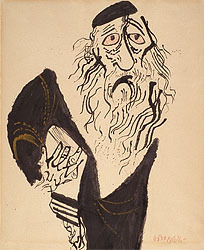FOCUS IN/ON - William Gropper
Gropper and the Warsaw Ghetto

William Gropper, 1897-1977 The Wanderer, c. 1960 Ink with wash on paper, 16" x 14" Hillstrom Museum of Art, gift of Reverend Richard L. Hillstrom ('38)
Five years later, in 1948, Jewish American artist William Gropper visited the site of the Warsaw Ghetto. Gropper, the grandson of Jewish immigrants, had sought an art education against great economic odds: "Right then," Gropper has stated, "I began to realize that you don't paint with color-you paint with conviction, freedom, love, and heart-aches, with what you have."
Years later, Gropper still fiercely adhered to the notion that art must be politically informed and morally grounded. In an interview given when he was 70, he declared: "That's my heritage. I'm from the old school, defending the underdog. Maybe because I've been an underdog or still am. I put myself in their position. I feel for the people. I have to face things in the most brutal way that I can and let it out and then feel better. Maybe it's my heredity or maybe it's my way of life. I can't close my eyes and say it is the best of all possible worlds and let it go at that. I become involved."
So, by virtue of both his heritage and his life experience, it was perhaps inevitable what would happen when Gropper went to Warsaw in 1948. He had already published a pamphlet on the Nazi atrocities at the small Czech town of Lidice: after high-ranking Nazi Reinhard Heydrich was ambushed on the road near Prague in May, 1942, the Nazis shot all the men in the nearby town of Lidice, burned the entire town to the ground, and deported the women and children to Ravensbrück and other German concentration camps. Gropper also created the illustrations for a small book titled Never to Forget: The Battle of the Warsaw Ghetto, in collaboration with author Howard Fast who wrote the accompanying poem (the entire text of this 1946 publication can been seen at www.trussel.com/hf/warsaw.htm.) Now, standing in the ruins of the Warsaw Ghetto in 1948, Gropper was face to face with both Jewish heroism and Nazi inhumanity.
Gropper made a pledge: that each year he would draw or paint a memorial to the victims of the Warsaw Ghetto. The Wanderer is likely one of that series. It is comparable to several other works by Gropper of which reproductions have been published, all of Jewish men garbed in traditional prayer shawl. Two of these date from during the War: Prayer from 1944, and De Profundis from 1943 or 1944. The latter includes a Hebrew inscription of title, which is from the opening line of Psalm 130 (Psalm 129 in the Hebrew version), "Out of the depths I cry to you, O Lord." In De Profundis, Gropper depicts the man wearing a phylactery, or tefillin, which is a small box containing a quotation from Hebrew scripture and strapped to the left arm and forehead by Jewish men as they recite morning prayers. Phylacteries are also worn by the figures in Gropper's Prayer of 1955 and his Dedication of 1966, the latter of which carries the inscription "dedicated to the memory of the victims in the Warsaw Ghetto." In this painting, the man raises his fists to heaven, his mouth open, in a gesture of rage. Others of the related works depict the old, bearded man in a posture of supplication, of prayer, of sadness, perhaps of bafflement. These include the afore-mentioned paintings titled Prayer (1944 and 1955) and De Profundis (1943 or 1944), plus Prayer Shawl from 1962 and another work titled Dedication, from 1964. The Wanderer from the Hillstrom Collection is similar to these images in the despondency that is read on the man's face.